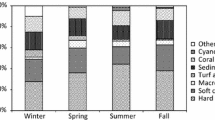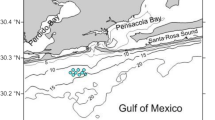Abstract
The abundance and productivity of benthic microalgae in coral reef sediments are poorly known compared with other, more conspicuous (e.g. coral zooxanthellae, macroalgae) primary producers of coral reef habitats. A survey of the distribution, biomass, and productivity of benthic microalgae on a platform reef flat and in a cross-shelf transect in the southern Great Barrier Reef indicated that benthic microalgae are ubiquitous, abundant (up to 995.0 mg chlorophyll (chl) a m−2), and productive (up to 110 mg O2 m−2 h−1) components of the reef ecosystem. Concentrations of benthic microalgae, expressed as chlorophyll a per surface area, were approximately 100-fold greater than the integrated water column concentrations of microalgae throughout the region. Benthic microalgal biomass was greater on the shallow water platform reef than in the deeper waters of the cross-shelf transect. In both areas the benthic microalgal communities had a similar composition, dominated by pennate diatoms, dinoflagellates, and cyanobacteria. Benthic microalgal populations were potentially nutrient-limited, based on responses to nitrogen and phosphorus enrichments in short-term (7-day) microcosm experiments. Benthic microalgal productivity, measured by O2 evolution, indicated productive communities responsive to light and nutrient availability. The benthic microalgal concentrations observed (92–995 mg chl a m−2) were high relative to other reports, particularly compared with temperate regions. This abundance of productive plants in both reef and shelf sediments in the southern Great Barrier Reef suggests that benthic microalgae are key components of coral reef ecosystems.





Similar content being viewed by others
References
Bell PRF (1992) Eutrophication and coral reefs—some examples in the Great Barrier Reef. Water Res 26:553–568
Berkelmans R, Oliver J, Byron G, Olds J (1998) Heron Island: the history of the Bund Wall and an impact assessment of its 1993 redevelopment on nearby coral communities. In: Proceedings of the Australian Coral Reef Society 75th Anniversary Conference, Heron Island October 1997. School of Marine Science, The University of Queensland, Brisbane, Australia, pp 11–28
Birkeland C (ed). (1997) Life and death of coral reefs. Chapman, New York, pp 140–147
Brodie J (1995) Terrestrial runoff and the Great Barrier Reef. Australas Sci 16:23–25
Brodie J, Furnas M (1996) Cyclones, flood plumes and natural water quality extremes in the Great Barrier Reef. In: Huner HM, Eyles AG, Rayment GE (eds) Downstream effects of land use. Queensland Department of Natural Resources, Queensland, pp 367–374
Brodie J, Mitchell AW (1992) Nutrient composition of the January 1991 Fitzroy River flood plume. In: Byron GT (ed) Workshop on the impacts of flooding, workshop series no. 17. Great Barrier Reef Marine Park Authority, Townsville, pp 56–74
Brown BE (1997) Disturbances to reefs in recent times. In: Birkeland C (ed) Life and death of coral reefs. Chapman, New York, pp 354–379
Bunt JS, Lee CC, Lee E (1972) Primary productivity and related data from tropical and subtropical marine sediments. Mar Biol 16:28–36
Cadée GC, Hegemann J (1974) Primary production of the benthic microflora living on tidal flats in the Dutch Wadden Sea. Neth J Sea Res 8:260–291
Cadée GC, Hegemann J (1977) Distribution of primary production of the benthic microflora and accumulation of organic matter on a tidal flat area, Balgzand, Dutch Wadden Sea. Neth J Sea Res 11:24–41
Capone DG, Dunham SE, Horrigan SG, Duguay LE (1992) Microbial nitrogen transformations in unconsolidated coral reef sediments. Mar Ecol Prog Ser 80:75–88
Carlton RG, Wetzel RG (1988) Phosphorus flux form lake sediments: effect of epipelic algal oxygen production. Limnol Oceanogr 33:562–570
Charpy L, Charpy-Roubaud CJ (1990a) A model of the relationship between light and primary production in an atoll lagoon. J Mar Biol Assoc UK 70:357–369
Charpy L, Charpy-Roubaud CJ (1990b) Trophic structure and productivity of the lagoonal communities of Tikehau atoll (Tuamotu Archipelago, French Polynesia) Hydrobiology 207:43–52
DeJonge VN, Colijn F (1994) Dynamics of microphytobenthos biomass in the Ems estuary. Mar Ecol Prog Ser 104:185–196
Delgado M, DeJonge V, Peletier H (1991) Experiments on resuspension of natural microphytobenthos populations. Mar Biol 108:321–328
Dennison WC, Abal E (1999) Moreton Bay study: A scientific basis for the healthy waterways campaign. South East Queensland Regional Water Quality Management Strategy, Brisbane, Australia
Dubinsky Z, Stambler N (1996) Marine pollution and coral reefs. Global Change Biol 2:511–526
Estrada M, Valiela I, Teal JM (1974) Concentration and distribution of chlorophyll in fertilized plots in a Massachusetts salt marsh. J Exp Mar Biol Ecol 14:47–56
Furnas MJ, Mitchell AW (1988) Large scale estimates of phytoplankton primary production in the Great Barrier Reef. Proc 6th Int Coral Reef Symp, Vol. 2, pp 557–562
Furnas MJ, Brodie J. (1996) Current status of nutrient levels and other water quality parameters in the Great Barrier Reef. In: Hunter HM, Eyles AG, Rayment GE (eds) Downstream effects of land use. Queensland Department of Natural Resources, Queensland, pp 9–21
Gabric AJ, Hoffenberg P, Boughton W (1990) Spatio-termporal variability in surface chlorophyll distribution in the Central Great Barrier Reef as derived from CZCS imagery. Aust J Mar Freshwater Res, 41:324–351
Gould DM, Gallagher ED (1990) Field measurements of specific growth rate, biomass, and primary production of benthic diatoms of Savin Hill Cove, Boston. Limnol Oceanogr 35:1757–1770
Harris G, Bately G, Fox D, Hall D, Jernakoff P, Mollowy R, Murray A, Newell B, Parslow J, Skyring G, Walker S (1996) Port Phillip Bay environmental study final report. CSIRO, Canberra, Australia
Hatcher BG (1997) Organic production and decomposition. In: Birkeland C (ed). Life and death of coral reefs. Chapman, New York, pp 140–174
Henriksen K, Hansen JI, Blackburn TH (1980) The influence of benthic infauna on exchange of inorganic nitrogen between sediment and water. Ophelia [suppl] 11:249–256
Johnstone RW (1989) The significance of coral lagoon sediments in mineralization of organic matter and inorganic nitrogen fluxes. PhD dissertation, University of Sydney
Johnstone RW, Koop K, Larkum AWD (1990) Physical aspects of coral reef lagoon sediments in relation to detritus processing and primary production. Mar Ecol Prog Ser 66:273–283.
Koop K, Both D, Broadbent A, Brodie J, Bucher D, Capone D, Coll J, Dennison W, Erdmann M, Harrison P, Hoegh-Gulfberg O, Hutchings P, Jones GB, Larkum AWD, O’Neil J, Steven A, Tentor E, Ward S, Williamson J, Yelowlees D (2001) ENCORE: the effect of nutrient enrichment on coral reefs. Synthesis of results and conclusions. Mar Pollut Bull 42:91–120
Kromm M (1991) Importance of benthic productivity in controlling the flux of dissolved inorganic nitrogen through the sediment-water interface in a hypertrophic marine ecosystem. Mar Ecol Prog Ser 78:163–172
Larkum AWD (1983) The primary productivity of plant communities on coral reefs. In: DJ Barnes (ed) Perspectives on coral reefs. Clouston, Canberra, pp 221–227
Lukatelich RJ, McComb AJ (1986) Distribution and abundance of benthic microalgae in a shallow southwestern Australian estuarine system. Mar Ecol Prog Ser 27:287–297
MacIntyre HL, Cullen JJ (1996) Primary production by suspended and benthic microalgae in a turbid estuary: time-scales of variability in San Antonio Bay, Texas. Mar Ecol Prog Ser 145:245–268
MacIntyre HL, Geider RJ, Miller DC (1996) Microphytobenthos: the ecological role of the “secret garden” of unvegetated, shallow-water marine habitat. I. Distribution, abundance and primary production. Estuaries 19:186–201
Matsukawa Y, Sasaki K (1986) Budgets of nitrogen, phosphorus and suspended solids in an intertidal flat. Bull Jpn Soc Sci Fish 52:1791–1797
McCook LJ (2001) Competition between coral and algae turfs along a gradient of terrestrial influence in the nearshore central Great Barrier Reef. Coral Reefs 19:419–425
McCook LJ, Jompa J, Dias-Pulido GD (2001) Competition between corals and algae in coral reefs: a review of evidence and mechanisms. Coral Reefs 19:400–417
Mille DC, Geider RJ, MacIntyre HL (1996) Microphytobenthos: The ecological role of the “secret garden” of unvegetated, shallow-water marine habitat. I. Role in sediment stability and shallow-water food webs. Estuaries 19:202–212
Mitchell AW, Reghenzani JR, Junter HM, Bramley RGV (1996) Water quality and nutrient fluxes from river systems draining to the Great Barrier Reef Marine Park. In: Hunter HM, Eyles AG, Rayment GE (eds) Downstream effects of land use. Queensland Department of Natural Resources, Queensland, pp 23–33
Nielsson LP, Jönsson B, Lindström Swanberg I, Sundbäck K (1991) Response of a marine shallow-water sediment system to increased load of inorganic nutrients. Mar Ecol Prog Ser 71:275–290
Parsons TR, Maita Y, Lalli CM (1984) A manual of biological and chemical methods for seawater analysis. Pergamon, New York
Paterson D, Crawford R, Little C (1990) Subaerial exposure and changes in sediment stability of intertidal estuarine sediments. Estuarine Coast Shelf Sci 30:541–556
Riaux C (1983) Structure d’un peuplement estuarine de diatomées épipéliques du Nord-Finistére. Oceanol Acta 6:173–183
Rizzo WM, Wetzel RL (1985) Intertidal and shoal benthic community metabolism in a temperate estuary: studies of spatial and temporal scale of variability. Estuaries 8:342–351
Roelfsema CM, Phinn S, Dennison WC (2002) Spatial distribution of benthic microalgae on coral reefs determined by remote sensing. Coral Reefs 21:264–274
Roman MR, Tenore KR (1978) Tidal resuspension in Buzzards Bay, Massachusetts. I. Seasonal changes in the resuspension of organic carbon and chlorophyll a. Estuarine Coast Mar Sci 6:37–46
Round FE, Crawford RM, Mann DG (1990) The diatoms, biology and morphology of the genera. Cambridge University Press, Cambridge
Sokal RR, Rolff FJ (1981) Biometry. Freeman, San Francisco
Sournia, A (1976) Primary production of the lagoon of an atoll and the role of foram symbionts. Mar Biol, 37:29–32
Staunton-Smith J, Johnson CR (1995) Nutrient inputs from seabirds and humans on a populated coral cay. Mar Ecol Prog Ser 124:189–2000
Sundbäck K, Granèli W (1988) Influence of microphytobenthos on the nutrient flux between sediment and water: a laboratory study. Mar Ecol Prog Ser 43:63–69
Sundbäck K, Enorksson V, Granéni W, Pettersson K (1991) Influence of sublittoral microphytobenthos on the oxygen and nutrient flux between sediments and water. Mar Ecol Prog Ser 74:263–279
Tomas, C (1997) Identifying marine phytoplankton. Academic, New York
Underwood GJC, Phillips J, Saunders K (1998) Distribution of estuarine benthic diatom species along salinity and nutrient gradients. Eur J Phycol 33:173–183
Uthicke, S, Klumpp, DW (1997) Ammonia excretion by holothurians enhances production and turnover of benthic diatom communities. Proc 8th Int Coral Reef Symp/June 24–29, 1996/Smithsonian Tropical Research Institute, Balboa, Panama, pp 873–876
Acknowledgments
Financial support for the transect research was provided by a Great Barrier Reef Marine Park Authority Grant to W.C. Dennison. The authors gratefully acknowledge the assistance of Mark Waugh with the Fitzroy-Heron transect sampling and the University of Queensland Interdisciplinary Geology/Botany and Terrestrial and Marine Botany field classes with sample collections at Heron Island.
Author information
Authors and Affiliations
Corresponding author
Additional information
Communicated by Environmental Editor, B.C. Hatcher
Rights and permissions
About this article
Cite this article
Heil, C.A., Chaston, K., Jones, A. et al. Benthic microalgae in coral reef sediments of the southern Great Barrier Reef, Australia. Coral Reefs 23, 336–343 (2004). https://doi.org/10.1007/s00338-004-0390-1
Received:
Published:
Issue Date:
DOI: https://doi.org/10.1007/s00338-004-0390-1




